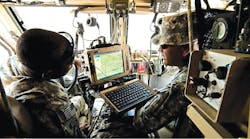By John McHale
ST. LOUIS - Boeing is part of a university-industry team that received a one-year, $2.75 million NASA contract to develop a reliable, cost-effective electronic technology that helps robotic and human space missions operate in environments of extreme cold and space radiation.
Led by principal investigator Dr. John D. Cressler, Byers Professor in the School of Electrical and Computer Engineering at the Georgia Institute of Technology in Atlanta, the team will continue to develop silicon germanium (SiGe) mixed-signal circuits for extreme environments, first initiated by NASA in 2005.
Mixed-signal circuits contain components that process analog and digital signals and are essential to the design of electronics that operate, control, monitor, and reconfigure many space systems.
The Phase 2A contract period concludes in April 2007, and Phase 2B is anticipated to run until April 2009. Under the contract, the team will build on its Phase 1 successes and continue to define application tasks; design and fabricate integrated circuits; develop simulation and modeling tools for design; assess reliability and radiation tolerance; develop integrated packaging; and qualify the performance of the devices in extreme cold temperatures and under incident radiation.
The technology could be used for upcoming NASA Robotic Lunar Exploration Program (RLEP) initiatives. Starting with the Lunar Reconnaissance Orbiter launch in October 2008, the RLEP is responsible for a series of robotic missions to the moon and supports future exploration activities for sustained robotic and human exploration to Mars and beyond.
SiGe electronics have intrinsic tolerance to space radiation and reduce the need for housing the electronics in warm boxes, conserving energy, reducing launch weight and improving reliability. This technology would enable extended mission range and duration, could be used in lunar landers, hoppers, rovers or data gathering stations, and also may benefit human space transportation systems for returning astronauts to the moon, Mars, and beyond.
“Future spacecraft returning to the moon will determine if ice exists in a form usable by humans in the permanently dark craters of the south polar region,” says Dr. Leora Peltz, the leader of the Boeing team in Advanced Network and Space Systems, a division of Boeing Integrated Defense Systems. “Water, if found, could be used as an in-space fuel source. SiGe technology could enable robots and humans to remain longer and accomplish more, either searching for existing resources or performing scientific missions on the lunar surface.”
The team includes the Georgia Institute of Technology, NASA’s Jet Propulsion Laboratory in Pasadena, Calif., Auburn University, the University of Tennessee, Vanderbilt University in Nashville, Tenn., the University of Maryland, the University of Arkansas, Boeing, BAE Systems, IBM, and Lynguent.
The project, which leverages and adapts SiGe technology for specific space exploration needs, is part of the NASA Exploration Systems Research and Technology Program in support of the nation’s Vision for Space Exploration.



